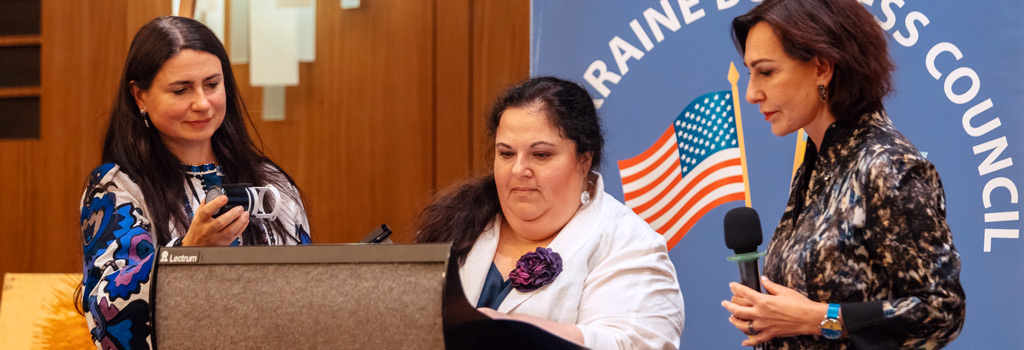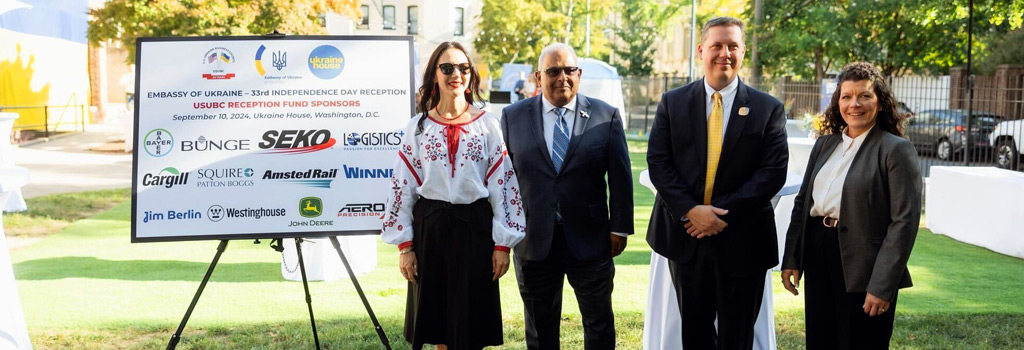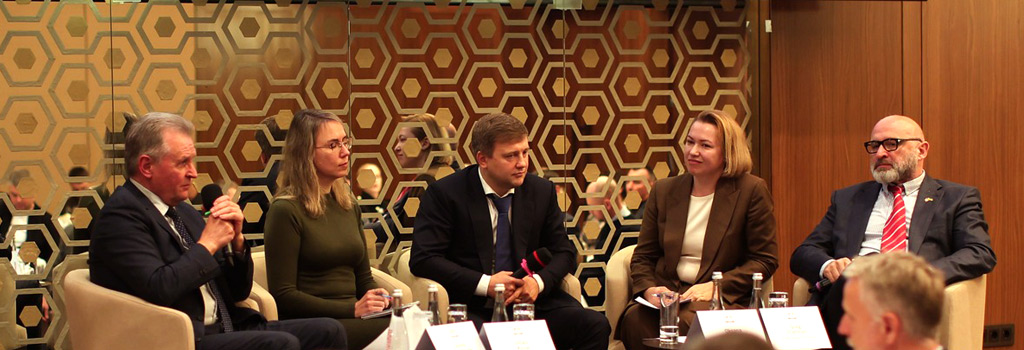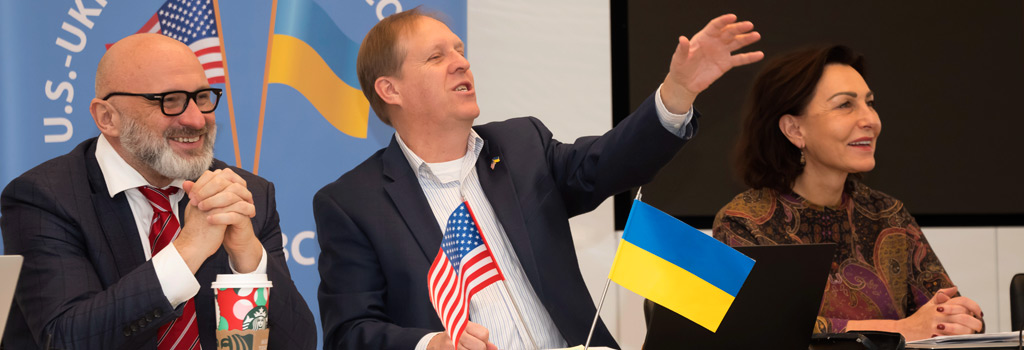Featured Galleries USUBC COLLECTION OF OVER 160 UKRAINE HISTORIC NEWS PHOTOGRAPHS 1918-1997
 Holodomor Posters
Holodomor Posters
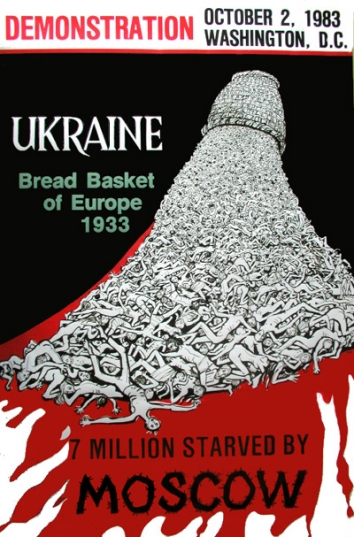
UKRAINE - MACROECONOMIC SITUATION – AUGUST 2017
 ANALYTICAL REPORT: by Oleg Ustenko, Djulia Segura, Valentyn Povroznyuk, Edilberto L. Segura
ANALYTICAL REPORT: by Oleg Ustenko, Djulia Segura, Valentyn Povroznyuk, Edilberto L. Segura
SigmaBleyzer private equity investment management firm & The Bleyzer Foundation (TBF), Kyiv, Ukraine
LINK: Ukr_Monthly_Ec_Report_August 2017.pdf
Published by U.S.-Ukraine Business Council (USUBC),
Washington, D.C., Mon, Sep 18, 2017
ANALYTICAL REPORT: by Oleg Ustenko, Julia Segura, Valentyn Povroznyuk, Edilberto L. Segura SigmaBleyzer multinational private equity firm & The Bleyzer Foundation (TBF), Kyiv, Ukraine
ANALYTICAL REPORT: by Oleg Ustenko, Julia Segura, Valentyn Povroznyuk, Edilberto L. Segura SigmaBleyzer multinational private equity firm & The Bleyzer Foundation (TBF), Kyiv, Ukraine Published by the U.S.-Ukraine Business Council (USUBC), Washington, D.C., Mon, Sep 18, 2017
WASHINGTON, D.C. - The "Ukraine Macroeconomic Situation – August 2017" analytical report is found below and as an attachment to this communication. The monthly macroeconomic situation report is prepared by the SigmaBleyzer multinational private equity firm, www.SigmaBleyzer.com, and The Bleyzer Foundation (TBF), www.BleyzerFoundation.org, Kyiv, Ukraine, who are members of the U.S.-Ukraine Business Council (USUBC), http://www.USUBC.org.
NOTE: The complete Ukraine - Macroeconomic Situation - report for August 2017 in PDF format, with a series of important, color charts and graphs, can be found in the attachment to this e-mail.
Executive Summary
- Though Russian-backed separatists continue their attacks against Ukrainian militants and civilians, their intensity significantly decreased in August 2017. There were almost no casualties during the month. This progress might be due to the increased pressure of the Western partners of Ukraine on Russia.
- Ukrainian Parliament has returned from recess. In his address to Verhovna Rada President Poroshenko asked MPs to concentrate on approving the reform agenda, particularly regarding pension system reform, approval of anticorruption legislation, privatization, and health care reform. More positively, Moody’s upgraded Ukraine’s credit rating to Caa2, with positive outlook, due to recent government reforms and better external situation.
- GDP grew by 2.4% yoy in the second quarter of 2017, a rate close to our annual prediction of 2.5% yoy for 2017. Monthly output data indicates that in July 2017 industrial production declined by 2.6% yoy, due principally to the continuation of hostilities and trade blockade in the East of Ukraine. Similarly, agricultural production fell by 1.9% yoy, due principally to bad weather. Retail trade turnover, however, showed an increase 6.8% yoy supported by increasing real wages. In July construction output continued to show good performance with a 17.3% yoy growth.
- The state budget was executed with a small deficit in July after three consecutive months of surpluses. But thanks to surpluses in local budgets, the cumulative consolidated budget surplus from the beginning of the year to the end of July further expanded by UAH 0.7 billion to UAH 52.8 billion (3.5% of period GDP).
- Consumer inflation saw little changes in July at a level of 15.9% yoy. The main drivers were faster growth in prices of whole foods and administratively regulated prices and tariffs. For the entire year, inflation should be around 10%.
- In the banking sector, deposits continued to expand in July. Growth of national currency deposits reached 11.8% yoy as both household and corporate deposits grew by 12.0% yoy and 7.9% yoy, respectively. At the same time, foreign currency deposits denominated in USD expanded at accelerated rate of 4.7% yoy. National currency bank crediting further accelerated in July. Household loans expanded by 13.9% yoy thanks to activated consumer loans.
- Inflows of foreign currency from exporters caused an extension of the UAH/USD exchange rate appreciation trend in August. The UAH/USD exchange rate appreciated in June and July, thanks to inflows of foreign currency from private sector financing. As a result, the exchange rate appreciated to UAH/USD 25.6 by the end of August.
- In July 2017, the deficit of the current account of the balance-of-payment reached USD 594 million. Although merchandise exports expanded by 9.9% yoy, reaching USD 2.9 billion, merchandise import increased at a faster pace of 22% yoy, to USD 4.0 billion, in July 2017. Since net financial inflows amounted to USD 302 million, international reserves declined by USD 285 million during July. Accordingly, the level of international reserves declined to USD 17.8 billion by the end of July 2017 (3.6 month of the future imports.)
Main Macroeconomic Indicators |
2011 |
2012 |
2013 |
2014 |
2015 |
2016 |
2017f |
|
GDP, USD billion |
163 |
173 |
180 |
130 |
87 |
93.4 |
97.2 |
|
Real GDP Growth, % yoy |
5.5 |
0.2 |
0.0 |
-6.6 |
-9.9 |
2.3 |
2.5 |
|
Fiscal Balance (incl. Naftogaz/Pension Fund),% of GDP |
-4.3 |
-5.5 |
-6.5 |
-11.7 |
-2.1 |
-2.3 |
-3.5 |
|
Public Debt, External and Domestic, % of GDP |
36.4 |
36.6 |
40.4 |
69.4 |
79.1 |
81.2 |
78.0 |
|
Consumer Inflation, eop, % yoy |
4.6 |
-0.2 |
0.5 |
24.9 |
43.3 |
12.4 |
10.0 |
|
Hryvnia Exchange Rate per USD, eop |
8.0 |
8.1 |
8.2 |
15.8 |
24.0 |
27.0 |
27.0 |
|
Current Account Balance, % of GDP |
-6.3 |
-8.3 |
-9.0 |
-4.1 |
-0.2 |
-4.1 |
-3.5 |
|
FDI, Net Annual Inflow, USD billion |
7.0 |
7.2 |
4.1 |
0.3 |
2.3 |
3.4 |
3.0 |
|
International Reserves, USD billion |
31.8 |
24.5 |
20.4 |
7.5 |
13.3 |
15.5 |
18.0 |
|
Public External Debt, USD billion |
33.3 |
32.1 |
31.7 |
34.9 |
42.6 |
42.5 |
47.0 |
|
Private External Debt, USD billion |
92.7 |
102.3 |
110.3 |
91.2 |
76.0 |
69.9 |
65.0 |
Political and Reform Developments
Though Russian-backed separatists continue their attacks against Ukrainian militants and civilians, their intensity significantly decreased in August 2017. There were almost no casualties during the month. This progress might be due to the increased pressure of the Western partners of Ukraine on Russia.
Ukraine’s issue continues to be an important question of all major international meetings. It was in agenda of the latest meeting of the U.S. Secretary of State Rex Tillerson with his Russian counterpart Foreign Minister Lavrov in August. Later in the month the conflict resolution was discussed during bilateral meetings of Mr. Lavrov with the European ministers of foreign affairs. The Ukrainian issue is in agenda of the UN Security Council for September. It is expected that the Council should decide on whether the UN peace keepers might be introduced to the conflict zone of Ukraine.
Ukrainian Parliament has returned from recess. In his address to Verhovna Rada President Poroshenko asked MPs to concentrate on approving the reform agenda. The agenda for September incudes number of issues related to legal support of overdue reforms. It is expected that main efforts would be concentrated in (i) pension system reform, (ii) establishment of anticorruption court and concrete results in anti-corruption efforts, (iii) privatization progress, and (iv) health care reform. All these reforms are in the list of requirements of the Ukrainian cooperation with IFIs and European institutions. More positively, Moody’s upgraded Ukraine’s credit rating to Caa2, with positive outlook, due to recent government reforms and better external situation.
Economic Growth
According to the latest report of the State Statistics Service of Ukraine, GDP grew by 2.4% yoy in the second quarter of 2017, a rate close to our annual prediction of 2.5% yoy for 2017.
Monthly output data indicate that in July 2017 industrial production showed a reduction of 2.6% yoy, due principally to the continuation of hostilities and trade blockade in the East of Ukraine. Similarly, agricultural production fell by 1.9% yoy, due principally to bad weather. Retail trade turnover, however, showed an increase 6.8% yoy, although it was lower than the 9% yoy increase achieved in June 2017. In July construction output continued to show good performance with a 17.3% yoy growth.
Within the industrial sector, Ukraine manufacturing expanded output by 2.6% yoy whereas output of mining of coal and lignite dropped by 26.8% yoy due to the hostilities in the East. The chemical subsector showed the best performance within manufacturing, with a growth rate of 26.7% yoy in July 2017. Other subsectors with positive rates of growth included: engineering, machinery and equipment (9.1% yoy), pharmaceutical products (8.5% yoy), rubber and plastic products (4.8% yoy), textiles (3.5% yoy), furniture (1.9% yoy), wood products, manufacture of paper and printing (1.1% yoy), and foodstuffs products and beverages (0.4% yoy). On the other hand, the main output falls were seen in electricity & gas, steam (drop by 11.9% yoy), coke & refined petroleum products (-11.6% yoy) and basic metals with fabricated metal products (with 4.9% yoy fall).
Regarding the categories of industrial goods, the highest output growth in July 2017 corresponded to investments goods (9.5% yoy growth), followed by customers durables (6% yoy growth) and then by short-term customer goods (1.3% yoy growth).
With reference to regional distribution of industrial output, the highest rates of growth in production were shown in the following regions: Kyiv region (58.5% yoy), Kirovohrad (19.7% yoy), Rivne (18.0% yoy), Khmelnytskiy (16.0% yoy), Ivano-Frankivsk (13.8% yoy), Sumy (13.5% yoy), Chernivtsi (11.0% yoy), Kharkiv (8.6% yoy), Lviv (7.7% yoy), Odesa (5.9% yoy), Mykolayiv (5.4% yoy), Cherkasy (3.9% yoy), Zhytomyr (3.2% yoy), Zaporizhzhya (2.3% yoy), and Volyn (1.8% yoy). However, the worse performance continued to be Luhansk and Donetsk regions, whose output dropped by 20% yoy and 19.3% yoy, respectively. Other regions also showed negative growth rates: at Kyiv city (fell by 7.4% yoy), Chernihiv (-6.5% yoy), Zakarpattya (-4.6% yoy), Poltava (-4.4% yoy), Dnipropetrovsk (-4% yoy), Ternopil (-3.4% yoy), Kherson (-2.6% yoy) and Vinnytsia (-1.7% yoy).
Fiscal Policy
The state budget was executed with a deficit in July after three consecutive months of surpluses. At the same time, the deficit was relatively small at UAH 2 billion and was the result of lower revenues as compared to June. Balance of the local budgets, in turn, returned to the positive territory in the reporting month as expenditures declined faster than revenues as compared to their values in June. The resulting surplus was equal to UAH 2.7 billion. Therefore, the cumulative consolidated budget balance from the beginning of the year to the end of July further expanded by UAH 0.7 billion to UAH 52.8 billion (3.5% of period GDP).
Despite a significant monthly decline of state budget revenues, they continued to expand at a fast pace in year-over-year terms in July. The 48% yoy growth was caused by accelerated growth in tax revenues and slightly decelerated but still high growth of nontax revenues. Tax revenues grew by 33.2% yoy on the back of improved VAT receipts, and expanded receipts from excise taxes on both domestically produced (19.8% yoy) and imported goods (35.4% yoy). Receipts from personal income tax, corporate profit tax, and taxes on international trade also expanded at fast pace. Fast growth of nontax revenues was ensured by transfer of the NBU’s profits for 2016.
Similarly to state budget revenues, local budget revenues continued to expand in year-over-year terms in July, despite some decline as compared to June. The mentioned growth was the result of faster growth in receipts from local own revenues, namely property tax, personal income tax, and single tax. The cumulative consolidated budget revenues from the beginning of the year increased by 57.9% yoy in January-July 2017.
In July 2017, growth of state budget expenditures decelerated to 9.8% yoy. This was the result of lower expenditures on current transfers and social security, whose growth decelerated to 9.6% yoy. These were caused by lower transfers to local budgets related to utility privileges and subsidies for the population. As it was observed in previous months, social security expenditures declined (by 23.9% yoy) due to lower transfers to the Pension Fund. Growth of payroll and capital expenditures also decelerated (to 27.5% yoy and 37.9% yoy, respectively) in the reporting month. At the same time, growth of expenditures on goods and services accelerated to 52% yoy and growth of the debt servicing expenditures returned to positive territory (5.8% yoy). The cumulative consolidated budget expenditures from the beginning of the year grew by 25.1% yoy over the first seven months of the year.
Monetary Policy
Inflation. Consumer inflation saw little changes in July. However, its level of 15.9% yoy was slightly above expectations due to faster growth in prices of whole foods and administratively regulated prices and tariffs. Core inflation accelerated to 7.3% yoy in accordance with expectations.
The prices of most of the major groups of goods and services experienced deceleration in growth in July, except for foodstuffs which experience some acceleration. This led to a moderate acceleration of the overall consumer inflation. In particular, growth in prices of foodstuffs, which account for around 30% of the consumer basket, accelerated by 1.3 percentage points to 16.3% yoy. This acceleration was the result of further increase in prices of meat and dairy products and slower than expected decline in prices of fruits and vegetables. Prices of meat and dairy products continued to grow mainly because of increased exports and slightly decreased production of meat. Slower decline in prices of fruits and vegetables was the result of lower harvest due to unfavorable weather conditions. Apart from foodstuffs, only healthcare services and services of restaurants and hotels reported acceleration in growth of prices. Other major groups of goods and services reported either deceleration or no changes in pace of growth.
Although consumer inflation was a bit higher than expected in July, we expect it to return to the forecasted trajectory soon. Therefore, we leave our consumer inflation forecast for 2017 unchanged at 10% yoy.
Banking Sector. Deposits continued to expand in July. Growth of national currency deposits edged down to 11.8% yoy as both household and corporate deposits saw marginal growth deceleration (to 12.0% yoy and 7.9% yoy respectively). At the same time, foreign currency deposits denominated in USD expanded at accelerated rate of 4.7% yoy. Growth of corporate deposits changed sign again returning to the positive territory (1.1% yoy), while household deposits continued to decline at virtually unchanged rate of 3.3% yoy.
National currency bank crediting further accelerated in July. Household loans expanded by 13.9% yoy thanks to activated consumer loans, while higher demand for loans in metallurgy, wholesale and retail trade, supply of electric energy, gas, steam, and air conditioning, and agriculture ensured faster growth in corporate national currency loans at 26.5% yoy. Thus, growth of the total national currency loans further accelerated to 22.6% yoy. At the same time the decline of the foreign currency loans denominated in USD accelerated back reaching 22.9% yoy. The deceleration in decline of household loans to 17.5% yoy was more than offset by acceleration in the decline of corporate loans to 24.1% yoy.
A decline in balances at the correspondent accounts of banks exceeded an increase in cash resources, which led to a monthly decline of the monetary base of 0.6% in July. Correspondently, the year-over-year growth of the monetary base further decelerated to 7.0% (by 1.3 percentage points as compared to June). At the same time, the increase in balances at deposit accounts ensured the money supply increase of 1% in the reporting month. Thus, the year-over-year growth of money supply accelerated moderately to 6.8%.
Hryvnia Exchange Rate. Inflows of foreign currency from exporters caused an extension of the UAH/USD exchange rate appreciation trend in August. Most foreign currency inflows were caused by traditional Ukrainian exports, such as agricultural and metallurgical products. The exchange rate was appreciating for most part of the month after a short and not very notable depreciation over the first two trading sessions. At the same time, the exchange rate returned to depreciation at the end of August. The main reasons for this depreciation were dividend repatriations which increased demand for dollars by banks with foreign capital, and prolonged weekend in the US because of the Labor Day celebrations. Thus, the UAH/USD exchange rate appreciated by only 0.5% to 25.6 UAH/USD in August.
The NBU continued to gradually liberalize foreign currency regulations in August. The regulator extended opportunities for banks’ own operations with foreign currency at the interbank forex market. In particular, it raised the size of allowed balances of purchases and sales of foreign currencies and banking metals by banks during one operational day from 0.5% to 1.0% of regulatory capital.
International Trade and Capital
Merchandise exports expanded by 9.9% yoy, reaching USD 2.9 billion, whereas merchandise import increased at a quicker pace of 22% yoy, to USD 4.0 billion, in July 2017.In July 2017, the deficit of the current account of the balance-of-payment of Ukraine increased by 38.5% year-over-year to USD 594 million (compared to a deficit of USD 429 million in July 2016). In January-July 2017, the accumulated deficit of the current account amounted to USD 2.1 billion (or 3.7% of GDP). This deficit was due to faster imports growth than exports. Ukraine deficit in merchandise trade reached USD 1,080 million, compared to a goods deficit of USD 621 million in July 2016.
As to Ukrainian merchandise exports, in July the main export growth took place in the following commodity groups: machinery & equipment (35.7% yoy), mineral products (28.9% yoy), industrial goods (16.7% yoy), timber and wood products (15.7% yoy), informal trade (12% yoy), agricultural products (11% yoy), ferrous & nonferrous metals (1,9% yoy). Only chemicals fell by 17% yoy.
Ukraine’s merchandise imports increased as follows: mineral products/energy (55.9% yoy), machinery & equipment (28.6% yoy), ferrous & nonferrous metals (25.4% yoy), chemicals (16.7%yoy), timber & wood products (16.4%yoy), agricultural products (12.7%yoy), industrial goods (8.3%yoy). Only informal trade fell by 24.7% yoy.
Regarding merchandise trade by regional orientation, Ukraine exports to Europe grew by 28.3% yoy, while imports from the EU expanded at a faster rate of 34.5% yoy in January-July 2017. In like manner, Ukraine merchandised trade showed similar results with the Russian Federation, with raising export from Ukraine by 23.4% yoy, while imported goods from Russian Federation had a higher growth by 38.8% yoy.
Net inflows of the financial account amounted to USD 302 million in July (of which USD 137 million were FDIs). These inflows were insufficient to cover the current account deficit of USD 594 million in July 2017. As a result the overall balance of payments had a deficit of USD 285 million. Accordingly, the level of international reserves declined to USD 17.8 billion by the end of July 2017, which were enough to cover 3.6 month of the future period of imports.









